Plesk Tutorial
This section walks you through the steps of performing the most essential web hosting tasks with the help of Plesk. By the end of the tutorial you will have created a functional website, added a database and a mail account, and you will also have learned how to manage DNS records and back up your website.
Step 1. Create Your First Website
To set up your first website, you need to follow these steps:
- Register a domain name.
- Add a domain in Plesk.
- Create your website.
Registering a Domain Name
Think of the domain name as your business’ address. Your customers will use it to find you online, so make sure it is a good one. The best domain names are short, easy to type, and easy to remember. An example of a domain name is example.com. Registering a domain name can be done through one of the many organizations called domain registrars. Your hosting provider will usually be able to assist you in registering a domain name as well. Web hosting services are often bundled with domain name registration offers, and vice versa.
Note: If you are a web hosting customer, make sure that when registering a domain name through your hosting provider, it is registered in your name. Otherwise, you may have trouble if you decide to change your hosting provider in the future.
Adding a Domain in Plesk
If you are a web hosting customer, your provider has probably already added your first domain for you. If they have not, contact your provider. If you are a web admin using the Power User view, you have configured your first subscription during the initial Plesk setup. Adding a domain in Plesk enables you to upload content, use Sitejet Builder, or install a content management system.
You can add more domains, but for the purpose of this section, your first domain will suffice.
Creating Your Website
There are several ways to create the content for your website. Each has its advantages and disadvantages. Here are some of the most used options:
- Employ a professional designer and upload content. This option guarantees you will get exactly what you want. However, it is also the most expensive one. The web designer will provide you with the files you will need to upload to your hosting account. You can do it using FTP or File Manager. To learn how to do this, see the Upload Content section.
- Deploy a website using Git. You can also collaborate with a web designer and use the Git version control system for maintaining your website. You will link and synchronize your website to a remote or local repository that your web designer can maintain. To learn how to do this, see the Deploy using Git section.
- Use Sitejet Builder. The Sitejet Builder tool that comes bundled with Plesk enables you to create websites using a web interface. Sitejet Builder’s Content Management System (CMS) provides a visual editor and template set that allows you to create web pages, add content, and edit settings such as your website’s name, keywords, and icons. You can use one of the provided templates to create a professional-looking website in a matter of minutes. To learn how to do this, see the Create your Website in Sitejet Builder section.
- Use a content management system. Content management systems (CMS for short) are third-party applications that enable you to create and maintain a website. They are highly versatile, and come with a large number of optional add-ons. CMS offer a greater degree of customization compared to Sitejet Builder, but demand more technical knowledge from the user. To learn how to use a CMS, see the Install a Content Management System section.
Option A. Upload Content
If you have coded your website yourself, or employed a web designer to do it for you, you need to upload the website content to Plesk before the website becomes available on the Internet. Plesk gives you the option to upload content either using FTP or File Manager. The instructions below explain how to do both - choose which option works best for you.
To publish a website using FTP:
- Download an FTP client program. You can choose any FTP client you
like. If you do not know what FTP client to choose, you can use
FileZilla:
- You can download FileZilla here: https://filezilla-project.org/download.php?type=client
- You can find FileZilla documentation here: https://wiki.filezilla-project.org/Documentation
- Connect to your subscription on the server using the FTP client. To
connect, you need the following information:
- FTP server address. The FTP address should be ftp://your-domain-name.com, where your-domain-name.com is your site’s Internet address.
- FTP username. This is identical to your system user name. Note that the system user name may differ from the username that you use for logging in to Plesk. To find what your system user name is, go to Websites & Domains > Hosting & DNS > Hosting. You will find it under Username. You can change your system user name if you wish.
- FTP password. This is identical to your system user password. If you do not know what your system user password is, go to Websites & Domains > Hosting & DNS > Hosting. You can reset the password under Password.
- Switch on the passive mode if you are behind a firewall. Refer to your FTP client documentation to learn how to enter the passive mode.
- Upload the files and directories of your site to the
httpdocsdirectory. If you use CGI scripts, place them in thecgi-bindirectory.
To publish a website using File Manager:
-
Go to Websites & Domains > domain name > File Manager and go to the
httpdocsdirectory. -
Click the
button and then do the following:
-
To upload a single file, click Upload File, locate, and then select the file you want to upload.
-
To upload a single file, multiple files, or a directory with the files therein, click Upload Directory and then drag files or directories to the dashed line box.
-
To upload a file not from your computer but from another website or FTP server, click Import file via URL, specify the the URL of the file, and then click Import. For example, the URL can be
https://example.com/image.pngorftps://user:password@example.com/example.tar.Note: File Manager supports the following protocols for file import: HTTP, HTTPS, FTP, and FTPS. Depending on the protocol, the user name and password in the URL path can be either optional or mandatory.
You have uploaded the file. If it was an archive, you have two more steps left.
-
-
Click the row corresponding to the archive and then click Extract Files. If the directory contains files whose names match those packed in the archive, select the “Replace existing files” checkbox. The unpacked files will then replace those in the directory.
-
Click OK.
Note: File Manager can extract files from the following archive formats: ZIP, RAR, TAR, TGZ, and TAR.GZ.
It is possible that the website you have uploaded requires a database to function. To learn how to create a database, see the Create a database section.
Option B. Deploy using Git
Plesk allows you to integrate with Git – the most popular source code management system used by web developers. You can manage Git repositories and automatically deploy websites from these repositories to a target public directory. And you can use Git as a transport for initial publishing and further updates.
To deploy a website using Git:
- Go to Websites & Domains and click Git.
- In the Git Repositories on <your domain>, click Add Repository.
- Set up the Git repository.
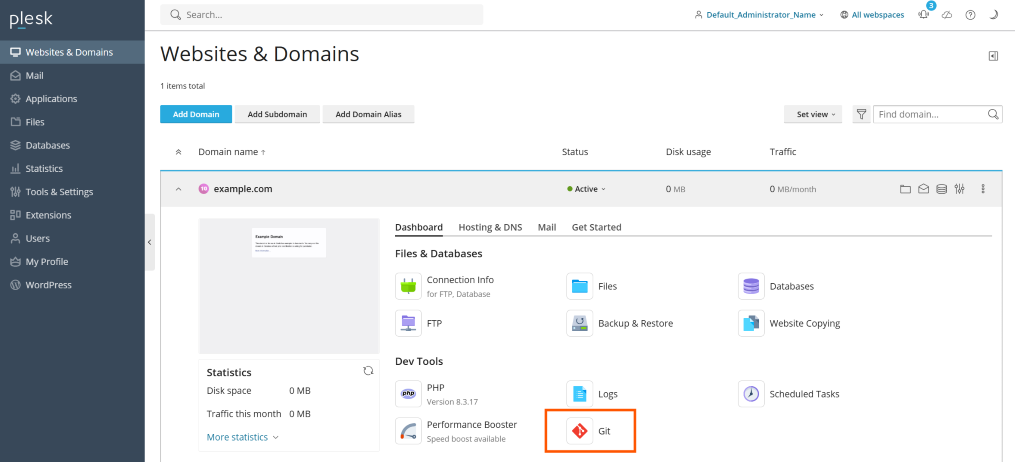
Option C. Create your Website in Sitejet Builder
Sitejet Builder’s Content Management System (CMS) provides a visual editor and template set that allows you to create web pages, add content, and edit settings such as your website’s name, keywords, and icons.
Sitejet Builder is free and installed by default. If you do not see its icon on the “Adding New Domain” drawer or on the “Get Started” tab, your subscription does not have the “Access to Sitejet Builder” permission. Contact your hosting provider to resolve this issue.
Creating a website with Sitejet Builder:
- Go to Websites & Domains and click Add Domain.
- In the Adding New Domain menu, select Sitejet Builder.
- Enter the rest of your website’s information, then click Add Domain. Sitejet Builder’s Choose a template interface will open.
- Edit the website using the Sitejet Website Builder (CMS).
Using Sitejet Builder on a website that already exists:
- Go to Websites & Domains, and find the domain name of the website you want to edit.
- Select the domain card, then select the “Get Started” tab.
- Click Create Website.
- Select the template that best suits your website’s needs.
- Edit the website using the Sitejet Website Builder (CMS).
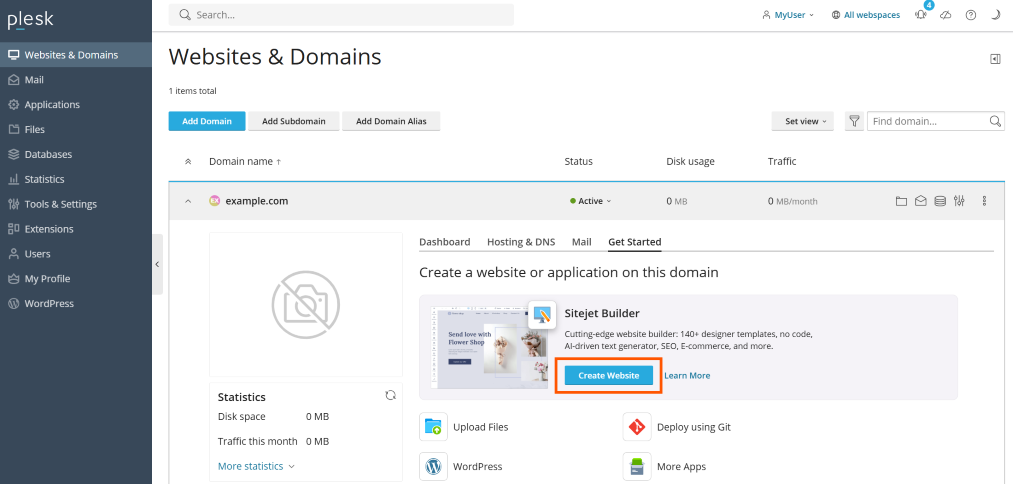
Caution: Publishing a Sitejet Builder website will remove the files in the document root of your website and replace them with your Sitejet Builder files. We strongly recommend creating a backup of your website’s contents before you publish your Sitejet Builder changes to prevent issues.
Creating your website in Sitejet Builder means that you do not need a database. Proceed to the next step to learn how to create an email account in Plesk.
Option D. Install a Content Management System
To create a website using a CMS:
- Go to Applications and click Install next to the application you want to install.
- Set up the CMS of your choice.
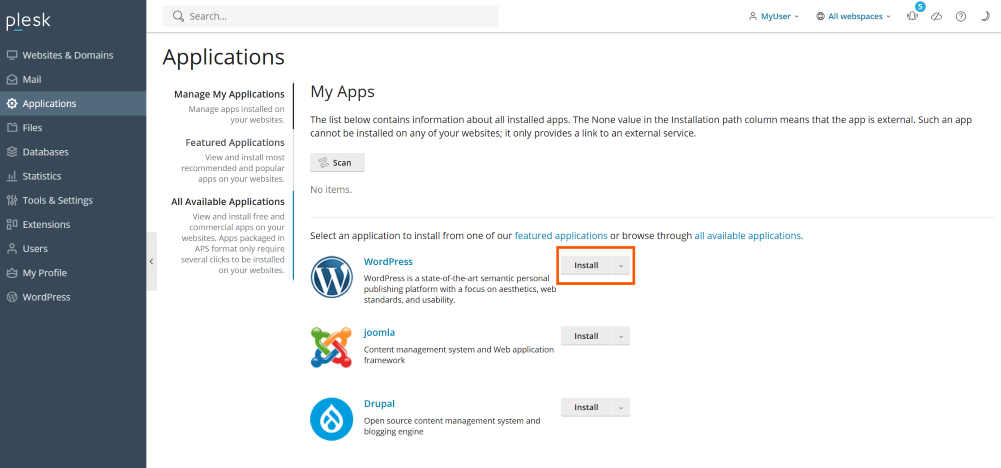
Learn more about using content management systems.
Note that installing a CMS following the instructions above means that a database will be created for your website automatically. Proceed to the next step to learn how to create an email account in Plesk.
Step 2. Create a Database
Databases are relational structures used for storing data. Databases are indispensable in modern web hosting, and most of the popular CMSs require a database to operate. Plesk supports MySQL, MSSQL and PostgreSQL database servers, and enables you to add, remove and access databases, as well as manage database users.
If your website does not require a database, proceed to the next step to learn how to create a mail account in Plesk.
To create a database and a database user:
- Go to Databases > Add Database.
- Enter the required information.
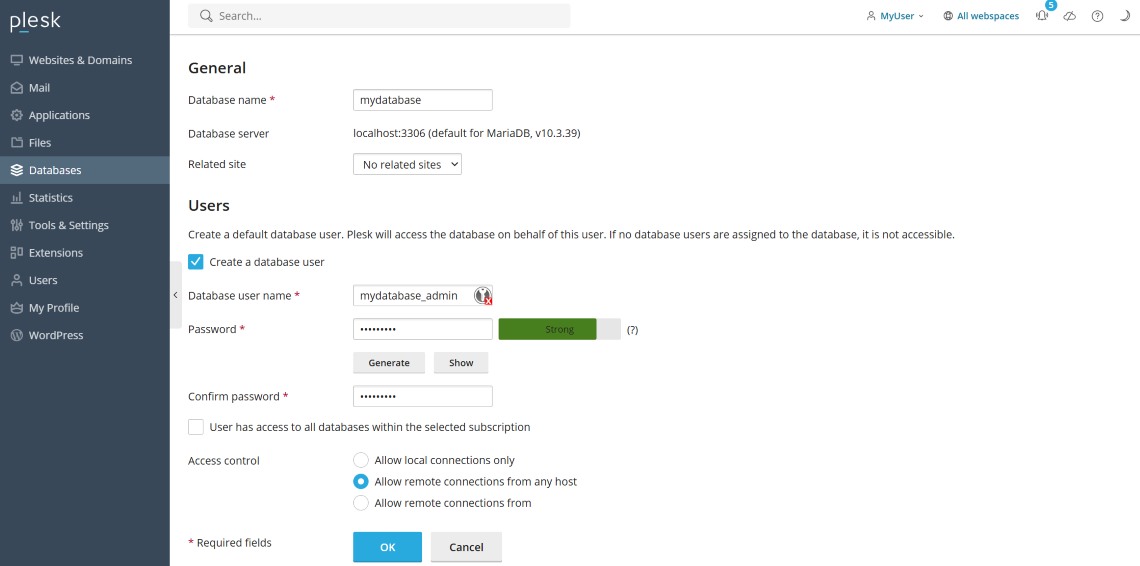
Step 3. Create an Email Account
The email service enables Internet users to send email messages to each other. Plesk can function as your email server. It also enables you to create email accounts and manage them, including performing a number of common email-related operations. Such operations include changing the password for an email account, enabling automatic replies, and so on.
If you do not need to create a mail account, proceed to the next step to learn how to add a custom DNS record in Plesk.
To create an email account:
- Go to Mail > Create Email Address.
- Enter the required information.
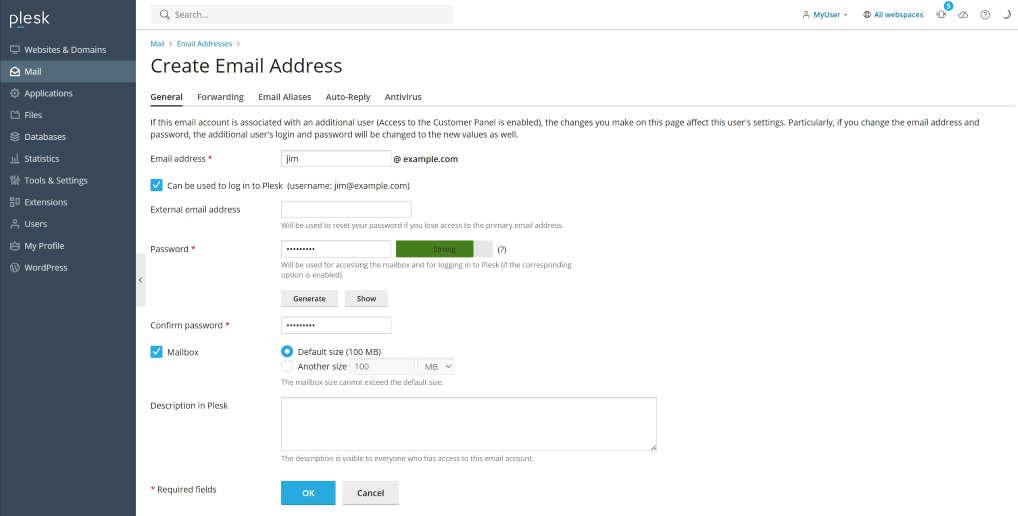
Step 4. Add a Custom DNS Record
DNS records serve to facilitate domain name translation and help visitors reach your website online. When a domain is created in Plesk, all the necessary DNS records are added automatically. However, Plesk also enables you to add custom DNS records, as explained below.
If you do not need to create a custom DNS record, proceed to the next step to learn how to back up your website.
To add a custom DNS record to the domain’s DNS zone, go to Websites & Domains > DNS Settings > Add Record.
To add a custom DNS record to a domain’s DNS zone:
- Go to Websites & Domains and find the domain name of the website for which you want to add a custom DNS record.
- Select the domain card and, on the “Hosting & DNS” tab, click DNS.
- Click Add Record.
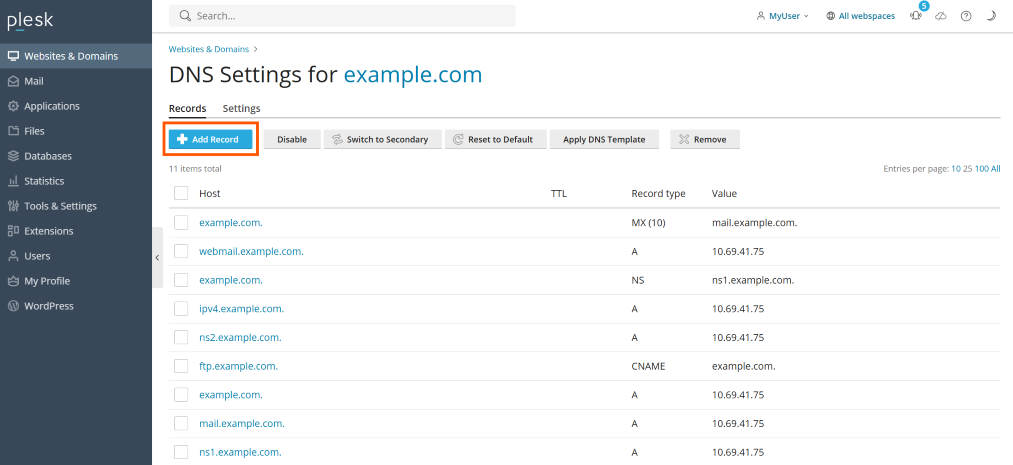
Step 5. Back Up Your Website
It is always recommended to keep a backup copy of your websites in case their configuration or content gets damaged or lost.
If you do not need to back up your website, proceed to the next step to learn how to change your password and log out of Plesk.
To access the backup function:
- Go to Websites & Domains and find the domain name of the website for which you want to manage backups.
- Select the domain card and, on the “Dashboard” tab, click Backup & Restore.
- Click Back Up.
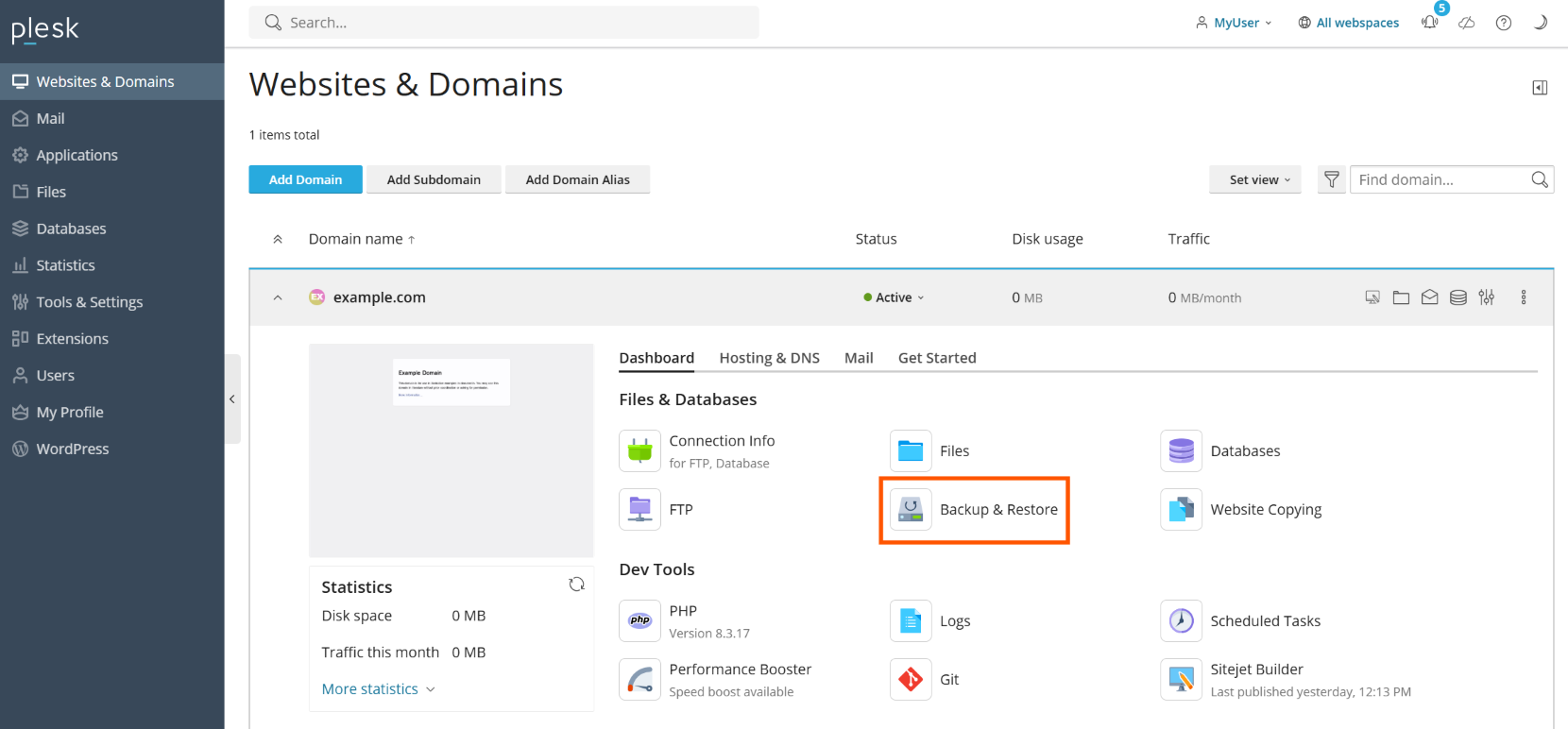
Step 6. Change Your Password and Log Out
If you are a web hosting customer, it is likely that the password you use to log in to Plesk was set up for you by your hosting provider.
To change your login password:
- Click your user name at the top of the page and click Edit Profile.
- Enter the required information to change the password and click OK or Apply.
- After you change the password, you must log out of Plesk and log in again with the new credentials. Click your user name at the top of the page, then click Log out.
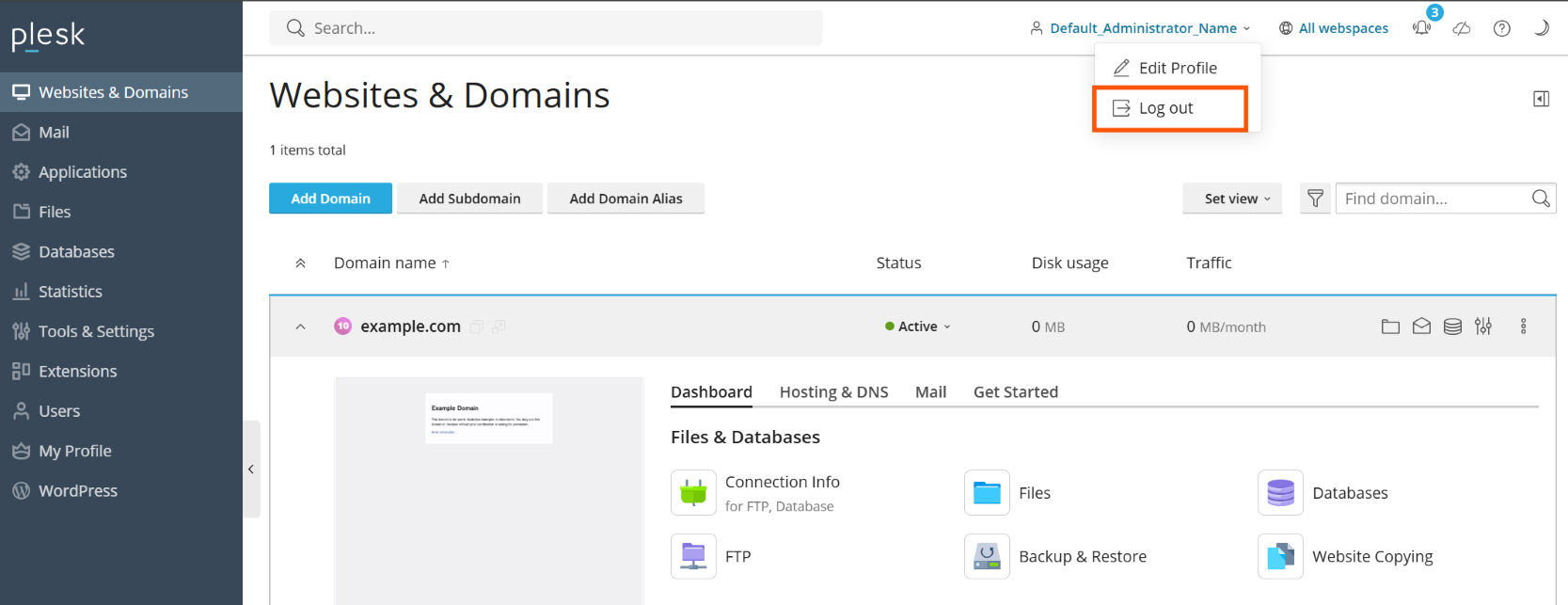
This concludes our tutorial. We hope it was useful, and encourage you to further explore Plesk and learn all the other ways it can make managing your web hosting account easier. The following resources will be helpful:
- The Plesk Functionality Explained section of this guide complements the tutorial by expanding on the topics it covered.
- The Plesk Customer’s Guide contains complete information about all the Plesk functionality available to web hosting customers.
- The Plesk Administrator’s Guide contains complete information about all the Plesk functionality available to the server administrator.
 button and then do the following:
button and then do the following:
